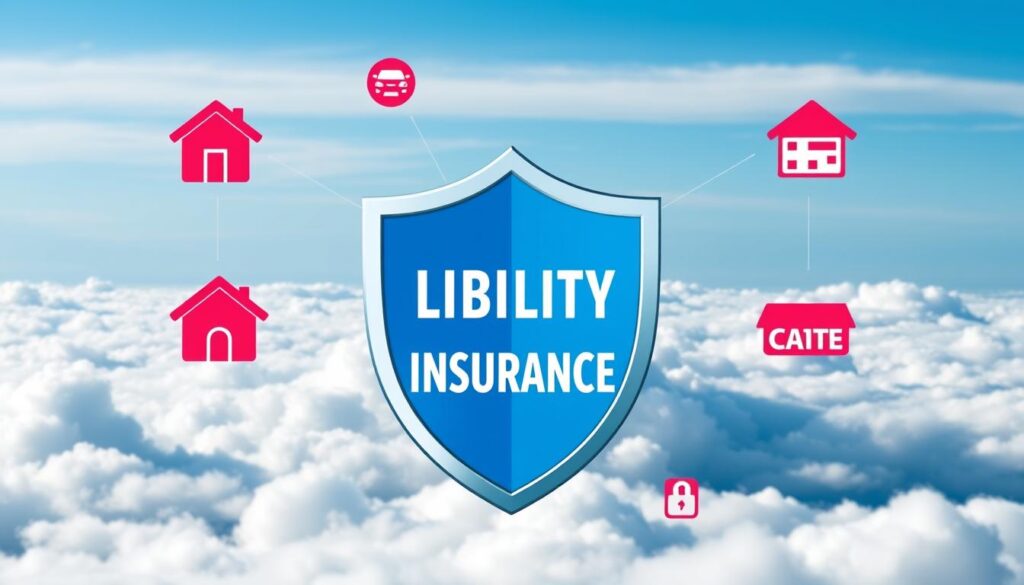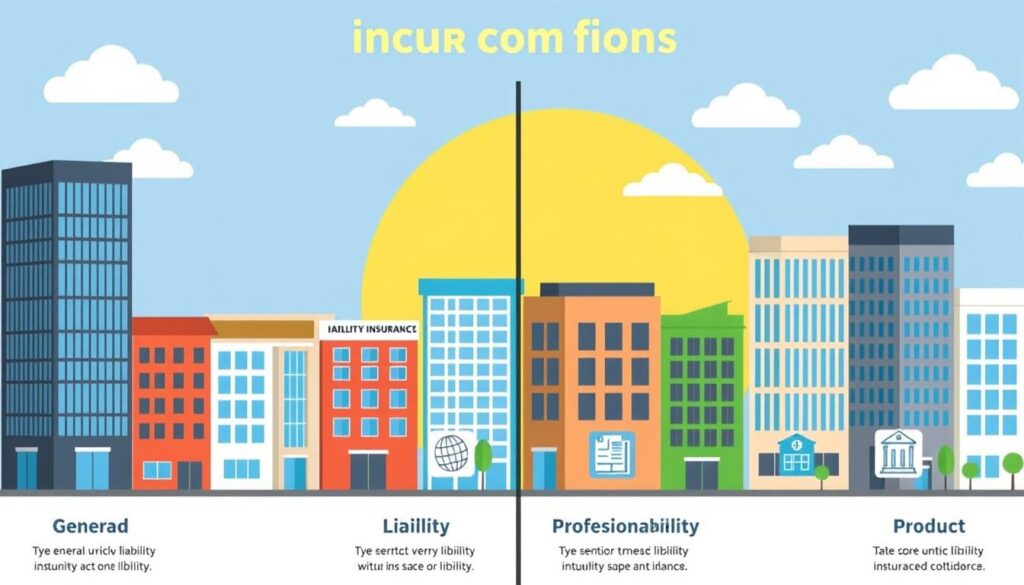Understanding liability coverage is vital for safeguarding your assets and securing your financial future. This guide explores the different types of liability insurance, their benefits, and how they protect your business or personal well-being.

Liability insurance offers monetary guardianship against claims of negligence, harm, or damage. It covers conduct or the conduct of your trade. Whether you’re an individual or a business owner, this guide will help you make informed decisions. You’ll learn how to choose the right liability insurance policies for your needs.
Key Takeaways
- Liability insurance protects your property and commercial well-being with the understanding of a suit or claim.
- Different types of liability insurance, such as general, professional, and product liability, offer specialized coverage for various scenarios.
- Liability insurance helps businesses manage risk and comply with legal requirements, ensuring the long-term sustainability of your operations.
- Understanding the coverage limits, exclusions, and cost factors associated with liability insurance is crucial for making informed decisions.
- Partnering with a reputable insurance provider can help you navigate the complexities of liability coverage and ensure you have the protection you need.
Understanding the Fundamentals of Liability Insurance
Liability insurance is a crucial part of a solid risk management plan. It offers liability protection by taking on the financial risks of legal claims and lawsuits. This is key for businesses and individuals looking to protect their assets and secure their future insurance basics.
What Makes Liability Insurance Essential
Liability insurance is vital for several reasons:
- It shields against financial losses from legal actions, like personal injury or property damage claims.
- It covers legal defense costs, including attorney fees and damages awarded in court, if a claim is successful.
- It allows businesses and individuals to risk transfer the financial impact of liability incidents, offering peace of mind and financial security.
Key Components of Liability Coverage
Liability insurance policies have several key elements:
- Bodily injury liability: Covers injuries to third parties due to the insured’s actions or negligence.
- Property damage liability: Provides coverage for damage to others’ property caused by the insured.
- Legal defense coverage: Covers legal representation and court expenses in case of a liability claim.
How Liability Insurance Works
Liability insurance works through risk pooling. Policyholders pay premiums to the insurer, who then uses these funds to cover claims. This risk transfer method helps protect businesses and individuals from the severe financial impacts of liability incidents.
“Liability insurance is the cornerstone of risk management, shielding individuals and businesses from the financial consequences of unforeseen events.”
Liability Insurance Explained: A Complete Guide to Types, Benefits, and Coverage
Understanding liability insurance can seem overwhelming. Yet, knowing the various types, their benefits, and policy features is key to safeguarding your business or personal interests. This guide will delve into the different liability insurance options. We aim to help you make informed decisions to manage your unique risks effectively.
Exploring Liability Insurance Types
Liability insurance offers many forms, each tackling specific risks. From professional liability for experts to general liability for daily operations, there’s a policy for you. Let’s explore the main liability insurance types and their benefits:
- Professional Liability Insurance: Protects businesses and professionals against negligence, errors, or omissions claims in their services.
- General Liability Insurance: Offers protection against third-party claims of bodily injury, property damage, or personal/advertising injury related to your business activities.
- Commercial Auto Liability Insurance: Covers liability for accidents involving vehicles used for business, including injuries, property damage, and legal defense costs.
- Product Liability Insurance: Shields manufacturers, distributors, and retailers from claims about defective or harmful products they’ve produced or sold.
- Umbrella Liability Insurance: Provides an extra layer of coverage to supplement primary liability policies, offering higher limits and broader protection.
Each liability insurance type has unique benefits, features, and risk assessment needs. By grasping these differences, you can customize your protection to meet your specific business or personal requirements.
“Liability insurance is like a safety net – it protects your business or personal assets from the financial consequences of unexpected events.” – Industry Expert
Professional Liability Insurance: Protecting Your Business Expertise
Your expertise is the cornerstone of your business. Yet, even the most diligent professionals face liability risks. Professional liability insurance, or errors and omissions (E&O) insurance, protects your livelihood.
Industry-Specific Coverage Requirements
Professions have unique liability risks. Insurance policies are often tailored to fit these needs. For example, healthcare providers need malpractice coverage, while IT consultants require protection against software errors. It’s vital to understand your industry’s specific needs when choosing insurance.
Claims-Made vs. Occurrence Policies
There are two main types of professional liability insurance: claims-created and incident. Claims-made procedures cover claims created during the tactics ending. Occurrence policies protect against incidents that happened during the policy period, even if claims are filed later. Choosing the right policy for your business is critical.
Coverage Limits and Deductibles
Coverage limits and deductibles greatly affect your policy’s cost and protection. Higher limits offer stronger protection but increase premiums. Higher deductibles lower costs but may require you to pay more for claims. Finding the right balance between coverage and cost is essential.
Investing in professional liability insurance is wise for service-based businesses. By understanding your industry’s needs, policy types, and coverage limits, you can secure a tailored solution. This protects your expertise and ensures peace of mind.
General Liability Insurance: Essential Protection for Every Business
Commercial general liability insurance is crucial for every business. It protects against various risks like premises liability, advertising injury, and bodily injury claims. Whether you run a small store or a large factory, this insurance is vital for your business’s success.
General liability insurance covers legal costs and damages from covered claims. This includes defense, court fees, and settlements. It shields your business from financial ruin. It protects against slip-and-fall accidents and advertising-related claims, ensuring your operations remain smooth.
Many clients and partners demand general liability coverage before working with you. Having this insurance shows your commitment to risk management. It builds trust with those you collaborate with.
| Coverage Type | Description |
|---|---|
| Premises Liability | Protects against claims of bodily injury or property damage that occur on your business premises. |
| Advertising Injury | Covers claims of libel, slander, copyright infringement, or other advertising-related issues. |
| Bodily Injury | Provides coverage for injuries sustained by third parties, such as customers or visitors, on your business property. |
Investing in commercial general liability insurance safeguards your business from many risks. It lets you focus on growth and success. Talk to an experienced insurance provider to find the best fit for your needs and budget.

Commercial Auto Liability: Safeguarding Your Business Fleet
Understanding business vehicle insurance can be challenging, yet it’s vital for protecting your fleet. Commercial auto liability coverage is essential for your business. It guards against financial risks from operating a fleet of vehicles.
Fleet Coverage Options
Businesses have various fleet protection options. From basic liability to comprehensive policies, the right commercial auto coverage prepares your business for any situation.
Risk Management Strategies
- Implement a robust driver safety program, including regular training and background checks.
- Regularly maintain and inspect your fleet to identify and address any potential issues.
- Consider adopting telematics technology to monitor driver behavior and optimize fleet performance.
Coverage Exclusions and Limitations
Understanding your business vehicle insurance policy’s limitations and exclusions is crucial. Common exclusions include personal use of company vehicles, damage from intentional acts, and claims related to drug or alcohol impairment. Reviewing your policy details helps identify coverage gaps and ensures your business is well-protected.
By proactively managing fleet protection and grasping the complexities of commercial auto liability insurance, businesses can protect their operations. This approach minimizes financial risks from operating a fleet of vehicles.
Product Liability Insurance: Protecting Manufacturers and Retailers
In today’s complex business landscape, product defect coverage, consumer protection, and manufacturing liability are paramount concerns for both manufacturers and retailers. Product liability insurance steps in as a crucial safeguard. It shields businesses from the financial repercussions of product-related claims and lawsuits.
Product liability security covers claims emergent from injuries, characteristic damage, or other misfortunes caused by broken produce. It protects against issues like faulty appliances, malfunctioning toys, or contaminated food items. This insurance helps protect manufacturers and retailers from the potentially crippling costs associated with product-related incidents.
Comprehensive Coverage for Manufacturers
For manufacturers, product liability insurance offers a comprehensive defense against a wide range of risks. This includes:
- Design flaws or manufacturing defects
- Inadequate safety warnings or instructions
- Failure to meet industry standards or regulations
- Damage or injury caused by a product’s use or misuse
Safeguarding Retailers and Distributors
Retailers and distributors also benefit from product liability coverage. They can be held responsible for the products they sell, even if the issue originated with the manufacturer. This insurance shields them from the financial burden of claims and lawsuits. It ensures they can continue to serve their customers with confidence.
| Coverage Benefit | Manufacturer | Retailer |
|---|---|---|
| Legal Defense | ✓ | ✓ |
| Damages and Settlements | ✓ | ✓ |
| Product Recall Expenses | ✓ | ✓ |
By investing in comprehensive product liability insurance, businesses can safeguard their operations. They protect their brand reputation and demonstrate their commitment to consumer protection and manufacturing liability.
“Product liability insurance is a critical investment for any business that manufactures or sells consumer goods. It can make the difference between weathering a crisis and facing financial ruin.”
Umbrella Liability Insurance: Extended Coverage for Peace of Mind
Liability insurance is crucial for protecting your business. Primary policies like general and professional liability offer basic coverage. However, sometimes, you need more. That’s where umbrella liability insurance comes in. It provides excess liability coverage and additional insurance protection for high-value assets and exposures.
Benefits of Additional Coverage Layers
Umbrella liability insurance acts as a backup when your primary policies are maxed out. It’s especially useful for businesses with high-value asset protection needs or facing high liability risks. With an umbrella policy, you can be confident that your company is protected from claims that exceed your primary coverage limits.
Cost-Effectiveness of Umbrella Policies
Umbrella policies are often more affordable than increasing your primary liability policy limits. They offer substantial protection at a lower cost. This makes them a cost-effective option for businesses looking to enhance their liability coverage.
When to Consider Umbrella Coverage
- Your business operates in a high-risk industry with significant liability exposure.
- Your primary liability limits are not sufficient to cover potential claims.
- You have significant assets, such as commercial property or high-value inventory, that need robust protection.
- Your business works with sensitive client information or provides specialized professional services.
Umbrella liability insurance is a key component of comprehensive business protection. It adds an extra layer of coverage, ensuring your company is ready for unexpected liabilities. This peace of mind is invaluable for any business.
Choosing the Right Liability Insurance Provider
When picking a liability insurance provider, several key factors must be considered. These include financial stability, customer service, policy customization, and industry expertise. The right provider can significantly protect your company.
To start, compare insurance company ratings and financial strength. Choose providers with a solid financial history and the capability to meet their policy commitments. Also, evaluate the quality of customer service. Good service includes quick responses, efficient claims handling, and overall support.
Customizing your liability insurance policy is also crucial. Every business is unique, so finding a provider that offers flexible coverage options is essential. This might involve adjusting coverage limits, adding specialized endorsements, or bundling policies for a more comprehensive risk management solution.
Lastly, industry expertise is vital. The best provider will understand your industry’s specific risks and regulations. They can offer specialized coverage and guidance to safeguard your business.
By carefully evaluating these factors, you can identify the insurance company comparison, policy customization, and customer service quality that best suit your business. This will ensure your company has the liability coverage it needs to succeed.

“Selecting the right liability insurance provider is a critical decision that can make or break your business’s financial security. Take the time to do your research and find a partner that truly understands your needs.”
Cost Factors and Premium Calculations in Liability Insurance
Calculating the cost of liability insurance premiums is intricate, involving a detailed assessment of various risk factors. Insurers meticulously examine industry-specific risks, claims history, and coverage limits to set accurate policy prices. Understanding these elements is crucial for businesses to make informed decisions when purchasing liability insurance.
Industry Risk Factors
The type of industry a company operates in significantly influences its liability insurance premiums. Industries like construction or healthcare, due to their inherent risks, often lead to higher insurance costs. Insurers evaluate the potential for accidents, lawsuits, and other liability exposures within each industry to set premium rates.
Claims History Impact
A business’s claims history is a critical factor in determining liability insurance pricing. Insurers closely review a company’s past claims, including frequency and severity, to predict future risks. Businesses with a history of frequent or costly claims face higher premiums to offset these increased risks.
Coverage Limit Considerations
The chosen coverage limits also impact liability insurance premiums. Higher coverage limits, offering more extensive protection, typically result in higher costs. Businesses must balance their risk tolerance and budget when selecting coverage limits to ensure adequate protection without overpaying.
By grasping these key factors, businesses can collaborate with their insurance providers to find the most suitable liability insurance coverage. This ensures they pay premiums that accurately reflect their unique risk profile.
“Liability insurance is the cornerstone of risk management for any business. Understanding the factors that influence premium costs is essential to ensure you’re getting the right coverage at the right price.”
Conclusion
In today’s fast-paced business world, liability protection is key to managing risks. By exploring the various liability insurance options, businesses and individuals can protect their assets and reputation. This guide has shown how liability insurance plays a crucial role in defending against unexpected events.
When evaluating your insurance needs, consider the specific requirements of your industry. Look at coverage limits and deductibles that fit your risk level. Understanding the differences between umbrella policies and claims-made vs. occurrence-based policies can help you make informed decisions. By prioritizing liability protection, you can ensure your business’s growth and success with confidence.
The choice of liability insurance is a proactive step towards managing risks. It ensures your hard work and achievements are protected from potential liabilities. With this knowledge, you can move forward with a sense of security, aiming for long-term success in your business or personal projects.










